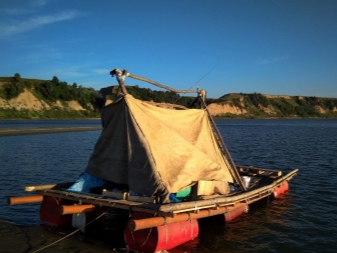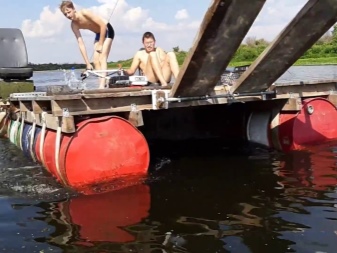How to build a raft from barrels?

Knowing how to build a raft from barrels is very useful for tourists, hunters, fishermen and simply residents of remote places. This article describes in detail how to make a raft with your own hands from 200 liter barrels according to the drawing. Attention is also paid to other subtleties of homemade rafts for rafting down the river from plastic and iron containers.


Construction features
Traveling to other countries can be very exciting, but sometimes people have to solve a more mundane task - how to make a boat for rafting down the river. Building a full-fledged boat is a very complex and difficult business, accessible only after professional training. It is much easier to build a raft from barrels, however, there are a number of important nuances that cannot be ignored. Otherwise, resting on the river will turn from a pleasant leisure into a difficult and even dangerous activity. The choice of models can be made to your taste - there are a lot of options.
A typical drawing of a raft on barrels looks something like this:
- overall dimensions - 4x6 m;
- use of 200 l barrels;
- the use of handrails 50x50;
- the use of plywood linings.


When drawing up the project, it is taken into account how convenient it will be to use the raft. He must:
- transfer the load from people and their property;
- manage without problems;
- maintain comfort while traveling;
- look attractive.


At the earliest stage, you can simply build on the desired look and not carry out calculations. However, soon they will still be needed, and ignoring this moment is fraught with unpleasant consequences - more than one floating craft overturned or even sank due to design errors. The displacement is assumed to be equal to the raft's own full load. As a first approximation, for a 200 liter barrel, the bearing capacity is assumed to be 200 kg.
The buoyancy of the boards is not taken into account. 5 or 6 steel drums can lift 1000 or 1200 kg of cargo. But the payload is less, since the barrels must also lift themselves. Even when traveling in a company of 3-4 people, this is quite enough. The size of the deck is determined by the ease of placement.
Often it is limited by the dimensions of the premises where advance fitting and partial assembly takes place.


Tools and materials
The need to use exactly 200 liter barrels is quite adequate. They are not only found quite often, but are also convenient to use. In addition, in many ready-made schemes, it is on them that a conjectural calculation is made. For long-distance rafting on the river, where you have to take a lot of loads, structures based on 8 metal barrels are often used. But in addition to iron, various types of plastic containers are often used.
Good steel is, of course, stronger and more reliable. However, this advantage is largely illusory. The fact is that if the raft hits a rock or an underwater rock, it is almost guaranteed to be damaged. A slight difference in the strength of metal and plastic means little here. Crucial is the skill of the travelers, who must avoid danger in every possible way.


But in any case, it is impossible to do with barrels alone. Pallets are often used to build a raft. Among them, in turn, standard euro pallets are best suited. Additionally take:
- timber;
- unedged boards;
- nails;
- self-tapping screws;
- oarlocks for oars;
- metal mounting angles (perforated);
- sometimes plumbing pipes.
Pure pallets are rarely used. Basically, they are sawn at 0.5 and 1 m.This is dictated not only by the convenience of work, but also by the increased rigidity of the deck. In this version, you can nail the boards to the supporting beam in the same way as is usually done with brickwork.
In any case, pallets are significantly cheaper than traditional boards of the required length, or even free of charge.



The timber is most often taken with a length of 3 m and a section of 5x5 cm. Its quantity is determined by a simple consideration: a distance of 0.5 m is needed between the individual elements. Plumbing pipes are not at all necessary, and it is much better to change them to a bar with a cross section of 5x7 cm. Such products are designed to guarantee rigidity in the longitudinal plane. If they are used correctly, you will not have to suffer from "walking" when walking or from the buildup of waves.
If suddenly a problem was discovered during the campaign (the timber was not taken into account or was out of order), you will have to strengthen the structure with tree trunks at least 15 cm thick. They are fastened on both sides with steel tape. Nails for the manufacture of flooring are taken so that you can bend them from the inside out. The fact is that even an increase in rigidity does not always help, and they sometimes begin to protrude outward right in the process of alloying. The barrels are fastened using metal mounting strips, they are attached to the guides of the longitudinal row.


Of the important elements for the raft, it is worth mentioning the control body. A traditional boat rudder won't do any good. Oars must be used for taxiing. One of them is made from an elongated pole, at the end of which a board is nailed. Such a pole facilitates repulsion from the bottom, snags and other obstacles; at the same time, rowing is simplified for a standing helmsman in deep areas.
Headwinds or parallel winds are often found on reservoirs. Then the sail of the tent makes it very difficult to advance. However, there is a way out - you will need to create a frame hut from thin logs. You can attach them to each other with a rope or reinforced tape.


You can fix the hut on the deck using long nails.
You will also need from materials and tools for work:
- scissors;
- hammer;
- roulette;
- building level;
- manual screwdrivers or cordless screwdrivers (for screwing in self-tapping screws);
- rope for tying;
- screws;
- silicone based putty;
- nippers;
- drill;
- miter saws.


Step-by-step instruction
You can make a raft from 4 or more barrels with your own hands using sleeves. When assembling the frame, nails are used. At the corners, corners of steel or self-tapping screws are attached. Usually, a pair of frame parts are made of the same size. The assembly is preferably carried out directly on the water.
The connection points are specially reinforced on the sides. For this purpose, unedged boards are used. To build a floor on a homemade raft, you need to screw it onto self-tapping screws with screwdrivers. The oarlocks make the raft more convenient for standing people. The optimum height of the oarlocks is at least 0.7 m.


Silicone sealant will prevent air from escaping through covers, holes and seams. Important: the sealing substance must dry. When creating a frame, two boards are used, going in the middle. They will help to strengthen the structure and at the same time prevent the barrels from going somewhere to the side. In all places where the boards are fastened, use 3 hardware for connection.
The flooring is first created in rough form. You need to see where which board will lie, and how many of them will be needed exactly. Ideally, terrace boards are used. Regular joinery requires small gaps. When the humidity rises, a tree devoid of gaps may warp.


How to build a raft from barrels, see the video below.













You have a raft for centuries ...)
The comment was sent successfully.